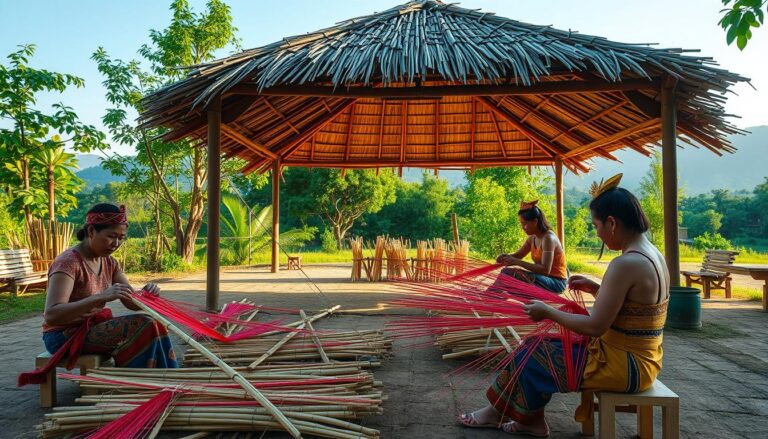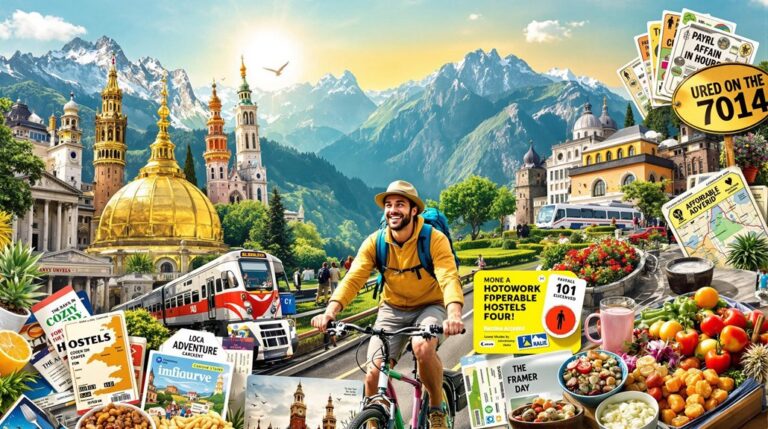Must-Visit Philippines Festivals for American Visitors

The Philippines offers an array of cultural festivals that showcase its rich heritage through vibrant celebrations.
Visitors can witness the stunning house decorations at Lucban’s Pahiyas Festival, experience the dynamic dancing at Cebu’s Sinulog Festival, admire the colorful masks of Bacolod’s MassKara Festival, and enjoy the floral displays at Baguio’s Panagbenga Festival.
These events connect locals and tourists alike, allowing participants to gain authentic insights into Filipino traditions. Each celebration presents unique customs that reflect the diverse regional cultures across the Philippine islands.
Highlights
Here are some must-visit festivals in the Philippines that American visitors would enjoy:
- Check out the Sinulog Festival in Cebu every January. It’s a lively event with colorful parades and dances honoring Santo Niño, a significant figure in Filipino culture.
- Head to Lucban for the Pahiyas Festival. Here, locals decorate their homes with fruits and rice wafers to pay tribute to San Isidro Labrador, the patron saint of farmers. It’s a spectacular sight and a great way to experience local traditions.
- Don’t miss the MassKara Festival in Bacolod. This festival is all about community spirit, with street dances and mask parades that highlight the resilience and joy of the people.
- Visit the Panagbenga Festival in Baguio, where you can marvel at flower floats and enjoy traditional performances. It’s a celebration of the region’s floral beauty and creative artistry.
- Experience the Moriones Festival in Marinduque. During Holy Week, participants wear Roman soldier costumes and reenact the story of Longinus, adding a unique cultural touch to your visit.
Pahiyas Festival: A Harvest Celebration in Lucban
The Pahiyas Festival in Lucban is a colorful celebration of gratitude and community that you should see. The town becomes a lively display of colors with beautiful decorations. Houses are decorated with fruits, vegetables, and kiping, which are rice wafers shaped like leaves.
Over 100 homes compete for the best decorations, making community involvement key. As you walk through the streets, you’ll notice the town’s strong agricultural roots.
This festival honors San Isidro Labrador, mixing tradition and creativity to bring families and visitors together to enjoy the local harvest and culture. The festival promotes local crafts and artwork, highlighting the creativity and skills of the community.
Sinulog Festival: Celebrating the Santo Niño in Cebu
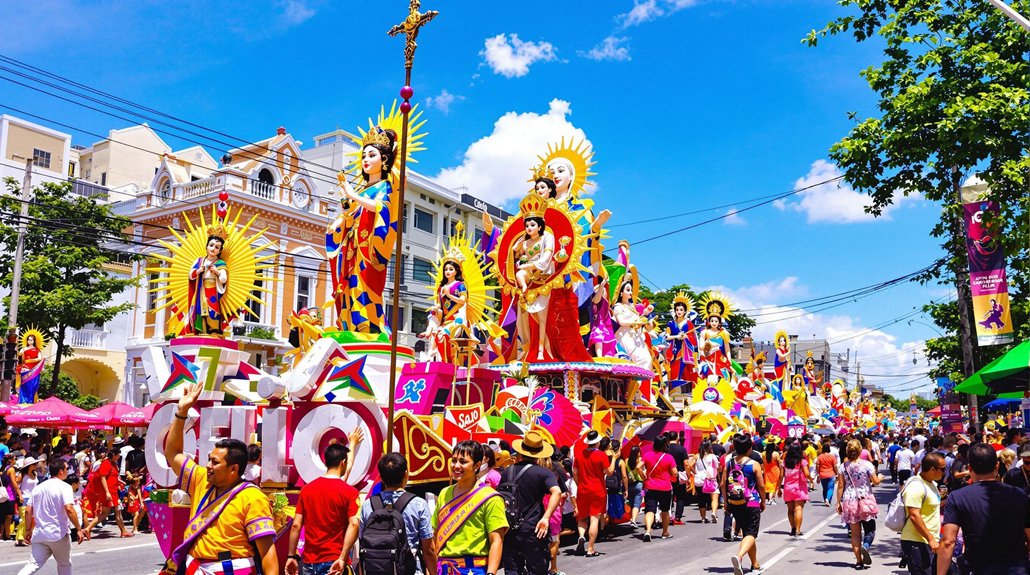
As you plan your trip to Cebu, try to visit during the Sinulog Festival. This annual event honors Santo Niño and highlights Cebu’s rich traditions.
Held every third Sunday of January, it turns Cebu City into a lively cultural celebration, drawing over a million attendees. The Sinulog dance, representing the gentle flow of a river, symbolizes the cultural change and Christian conversion of the Cebuano people. Participants wear vibrant and elaborate costumes, showcasing the vibrant culture and artistry of the festival.
Cebu City comes alive every third Sunday of January, celebrating cultural transformation and Christian conversion through the Sinulog dance.
- Grand Parish Parade: The main highlight of the festival.
- Street Parties: Join the lively celebrations.
- Fireworks: Enjoy the colorful night sky.
- Traditional Costumes: See the detailed Filipino craftsmanship.
- Cultural Shows: Watch concerts and contests.
MassKara Festival: Vibrant Masks and Costumes in Bacolod
When you visit Bacolod for the MassKara Festival, you’ll see bright parades and exciting performances that celebrate the city’s strength and lively spirit. This festival started as a way to overcome tough times, with the masks representing the region’s positive outlook.
The MassKara Queen pageant blends beauty with cultural representation, emphasizing local pride and unity. Join in on fun activities, like street dance contests and delicious food events, to understand why this celebration is a key attraction in the Philippines.
Colorful Parades and Performances
Imagine the MassKara Festival in Bacolod, a vibrant event where bright colors and lively performances engage everyone. This festival is special because it involves the whole community.
Here’s what you can expect:
- Parades: Performers wear colorful masks and costumes, expressing happiness and energy.
- Street Dances: Dancers move energetically to Latin and Philippine jazz music.
- Electric MassKara: A night parade with bright LED and neon lights lighting up the city.
- Community Involvement: Local groups and schools work together to make the event memorable.
- Interactive Shows: People watching often join in the fun.
Cultural Significance and History
As of October 2023, the MassKara Festival in Bacolod is a lively celebration that highlights cultural strength and community unity.
This festival began in the early 1980s during a tough economic period and was intended to lift spirits and show resilience. The name “MassKara” combines “mass” and “kara,” which means “face” in Hiligaynon, representing joy and determination through the festival’s colorful masks.
These masks aren’t just for decoration; they symbolize Bacolod’s strong spirit. By maintaining Hiligaynon culture and traditions, the festival brings the community together and fosters cultural pride.
Each mask is handmade, showcasing local creativity with a mix of traditional and modern designs, reflecting Bacolod’s ability to overcome challenges.
Moriones Festival: Holy Week Reenactment in Marinduque
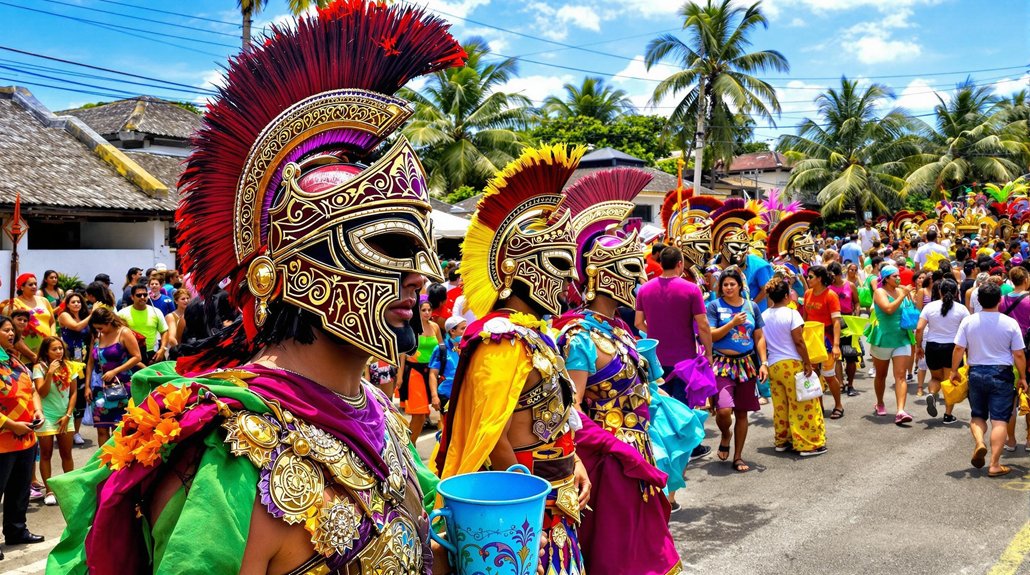
When you visit Marinduque during Holy Week, you’ll be immersed in the lively Moriones Festival. This event, based on the story of Longinus, brings history alive with masks representing Roman soldiers, rich in religious meaning.
The festival encourages community involvement, with locals dressing as Roman soldiers to honor the Passion of Christ. Spanning a week, the festival enlivens the streets, benefiting local businesses economically.
| Element | Description | Significance |
|---|---|---|
| Moriones Masks | Represent Roman soldiers | Deep cultural and religious value |
| Longinus Story | Symbol of conversion and martyrdom | Inspires both locals and visitors |
| Community Involvement | Locals participate as an act of penance or gratitude | Builds unity and pride |
| Festival Activities | Weeklong events and reenactments | Attracts tourists |
| Economic Benefit | Boosts local business income | Supports community livelihood |
Panagbenga Festival: A Blooming Celebration in Baguio
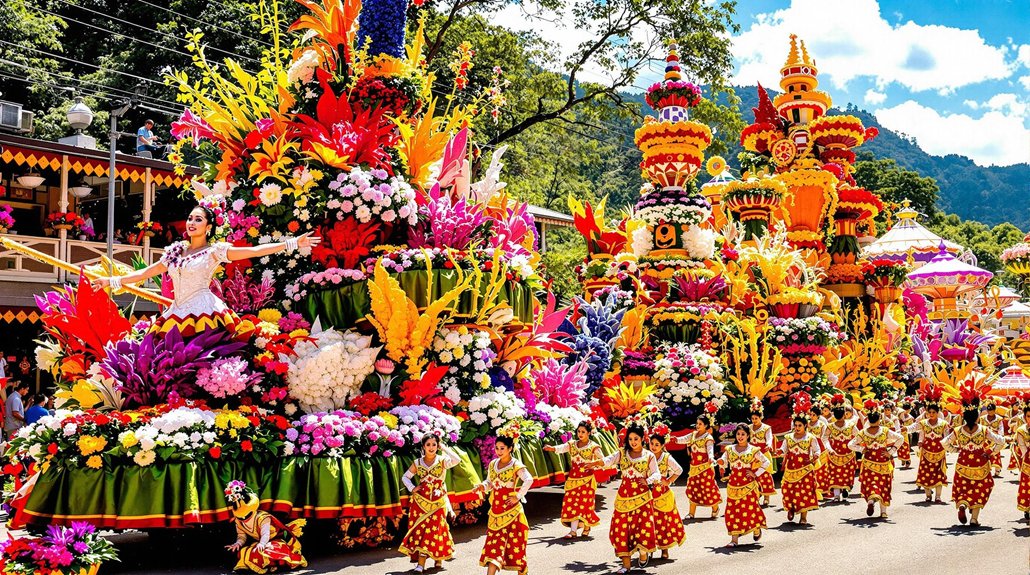
Every February, Baguio City comes alive with the Panagbenga Festival, a vibrant display of culture and flowers. This month-long event is a sensory delight, celebrating the city’s rich traditions and impressive floral artistry.
Picture yourself in a setting where:
- Floral floats move through the streets, each a creative masterpiece.
- Street dancers in colorful outfits showcase Cordillera culture.
- Market Encounter presents a wide array of local crafts and handmade goods.
- Cultural shows feature traditional dances and music.
- Fireworks light up the sky, ending the festival with a grand display.
Kaamulan Festival: Honoring Ethnic Tribes in Malaybalay
The Kaamulan Festival in Malaybalay City is a vibrant celebration of cultural heritage and unity. The festival, whose name comes from the Binukid word “amul,” meaning “to gather,” honors seven ethnic tribes: Bukidnon, Higaonon, Talaandig, Manobo, Matigsalug, Tigwahanon, and Umayamnon.
From late February to March 10, attendees can enjoy traditional dances, cultural performances, and lively street dancing competitions. Participants wear intricate traditional clothing, showcasing the tribes’ unique customs and traditions.
The festival also includes an agro-industrial fair and offers traditional Filipino foods, providing a deep dive into the rich culture of Bukidnon. The vibrant atmosphere of the festival is enhanced by the sights and sounds of indigenous music, offering an immersive experience into the heart of Mindanao’s cultural diversity.
Lechon Festival: A Culinary Delight in Batangas
When June arrives, Balayan in Batangas comes alive with the exciting Lechon Festival. Celebrating St. John the Baptist’s feast on June 24, this festival combines culture, food, and fun.
Picture pigs dressed in cultural outfits, parading in the Parada ng Lechon. The air is filled with the delicious smell of lechon being slow-roasted over charcoal, ensuring crispy skin.
- See creatively dressed lechon.
- Join water fights that symbolize baptism.
- Taste different lechon types, like lechon manok.
- Enjoy live music and performances.
- Feel the community spirit as roast pig is shared.
Pineapple Festival: Sweet Celebrations in Daet
As June begins, Daet in Camarines Norte comes alive with the Pineapple Festival, also known as the Pinyasan Festival. This event celebrates the Formosa pineapple’s rich history.
From June 15 to 24, the town buzzes with activity. Visitors can enjoy colorful street dances and lively float parades that showcase local culture.
At the agro-industrial fair, local produce is highlighted, and the food fair offers delicious pineapple-based dishes.
Community participation is essential, promoting unity and preserving traditions.
Exploring Daet during this time offers a genuine experience, celebrating agriculture and providing insight into local life.
Pangapog Festival: Harvest Festivities in Samal City
The Pangapog Festival in Samal City, Davao del Norte, is a vibrant celebration deeply rooted in the agricultural traditions of the Sama people, an indigenous group in the region. Held annually from August 1 to 7, this festival honors a bountiful harvest while preserving the cultural heritage of the community.
Key Highlights of the Festival
Traditional Rituals & Spiritual Ceremonies
- The festival begins with “Panawagtawag”, a prayer ritual led by a spiritual leader, invoking blessings for prosperity and gratitude for the harvest.
- Offerings of rice, fruits, and other farm produce are made to honor ancestors and nature spirits.
Cultural Dance Performances
- Dancers clad in colorful Sama attire perform traditional harvest dances, using props like woven baskets and fishing nets to depict farming and fishing traditions.
- Modern and folk dance competitions add a dynamic twist to the celebrations.
Indigenous Sports & Games
- Locals engage in traditional sports such as “Sipa sa Manggahan” (a kicking game using a rattan ball) and boat races, showcasing the community’s athleticism and teamwork.
Feasting & Local Delicacies
- A communal feast features native dishes like “Pangapog” (grilled seafood), rice cakes, and fresh tropical fruits.
- Visitors can also enjoy “Lami-Lami”, a traditional Sama dish made with coconut milk and fresh catch from the sea.
Street Parades & Community Unity
- A grand parade with decorated floats and street dancers fills the city with energy.
- The festival fosters strong community bonds, as locals and visitors come together to celebrate Samal’s rich culture.
Why It’s Worth Experiencing
- Authentic Indigenous Culture – Unlike commercialized festivals, Pangapog remains deeply connected to Sama traditions.
- Interactive & Engaging – Visitors can join dances, taste local food, and even participate in traditional games.
- Scenic Coastal Setting – Samal Island’s pristine beaches and lush landscapes provide a stunning backdrop for the festivities.
Vibrant Harvest Traditions
The Pangapog Festival in Samal City may not be as famous as other festivals, but its lively harvest traditions make a lasting impression.
Rooted in the customs of the Sama people, this festival expresses gratitude for a successful harvest. It invites you to engage with the community through shared ceremonies and meals.
Here, you can explore:
- Rituals that honor ancestors
- Exciting traditional sports
- Cultural performances highlighting Sama heritage
- Delicious local food
Cultural Dance Celebrations
Experience the lively cultural dance celebrations at the Pangapog Festival in Samal City. This event, held from August 1 to 7, showcases the rich heritage of the Sama people through dance and music.
The festival offers a blend of traditional and contemporary performances, with active participation from local leaders and community members in rituals and street dancing. Dancers wear colorful costumes and use props like baskets and nets to depict stories of harvest and unity.
| Event Details | Key Activities | Community Involvement |
|---|---|---|
| Rituals | “Panawagtawag” and prayers | Led by a spiritual leader |
| Performances | Traditional and modern dances | Local participation |
| Celebrations | Feasting and cultural games | Showcasing local pride |
Carabao Festival: Unique Traditions in Angono
Carabao Festival: Unique Traditions in Angono
The Carabao Festival in Angono, Rizal, is a one-of-a-kind celebration that honors the carabao (water buffalo), a symbol of agricultural heritage and rural life in the Philippines. Held every May 14-15, this festival blends religious devotion, cultural performances, and community spirit.
Key Highlights of the Festival
Carabao Parade & Blessing
- Farmers decorate their carabaos with vibrant garlands, ribbons, and even painted designs.
- The animals are paraded through the streets before receiving a blessing at the St. Clement Parish Church, ensuring a fruitful harvest.
Pahiyas-Inspired Decorations
- Similar to Lucban’s Pahiyas Festival, houses are adorned with kiping (rice wafers), fruits, and vegetables, showcasing Angono’s agricultural roots.
Street Dancing & Performances
- Locals perform traditional dances like the “Sayaw ng Kalabaw” (Dance of the Carabao), mimicking the movements of the beloved animal.
- Drumbeats and folk music fill the streets, creating an energetic atmosphere.
Art & Culture Showcase
- Angono, known as the “Art Capital of the Philippines,” integrates mural paintings and folk art into the festivities.
- Local artists display their works, celebrating the town’s creative legacy.
Religious & Agricultural Rituals
- The festival coincides with the feast of San Isidro Labrador, the patron saint of farmers.
- Farmers offer their harvests in gratitude, reinforcing the deep connection between faith and agriculture.
Why It’s a Must-See
- Authentic Rural Experience – Unlike commercialized festivals, the Carabao Festival remains deeply rooted in farming traditions.
- Community Spirit – Locals actively participate, making visitors feel welcome.
- Cultural Preservation – The event keeps age-old customs alive while embracing modern artistic expressions.
For travelers seeking a genuine, off-the-beaten-path festival, Angono’s Carabao Festival offers a fascinating glimpse into Filipino rural life and artistic heritage.
Frequently Asked Questions
What Is the Best Time to Visit the Philippines for Festivals?
To catch the best festivals in the Philippines, plan your visit between November and April. During these months, the weather is sunny and perfect for exploring the vibrant cultural events. This period is ideal for adventure seekers who want to experience the colorful celebrations and local traditions.
Are There Any Safety Tips for Attending Filipino Festivals?
When attending Filipino festivals, keep safety in mind by managing crowds effectively. Be aware of your surroundings and know where the nearest exits are. Keep your belongings secure and always stay with a friend. Understanding and respecting the local culture will help you enjoy the festival more.
How Do Locals Prepare for These Festivals?
Locals get ready for festivals by decorating their homes and streets with colorful designs. They wear traditional clothes to honor their culture. People come together to make art, practice dances, and cook special foods. They also mix in modern ideas to make the celebrations lively and unique.
Can Visitors Participate in Festival Activities?
Join in the festival fun by wearing local clothes, dancing, and enjoying traditional food. Getting involved helps you understand the culture better and feel part of the celebration.
What Cultural Etiquette Should Foreigners Be Aware of During Festivals?
When attending festivals, it’s important to show respect for local customs. Dress appropriately and modestly to fit in with the cultural norms. Try to learn a few basic phrases in the local language; it shows effort and can help you connect with people. Join in traditional activities to make your experience more meaningful. By respecting these practices, you’ll gain a deeper understanding and appreciation of the culture.





